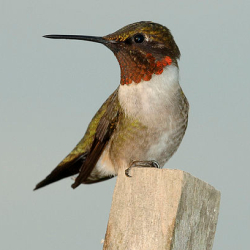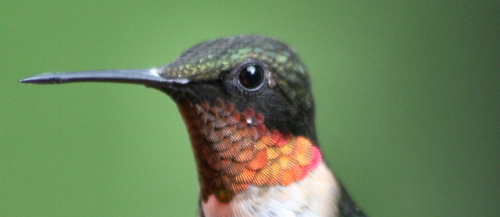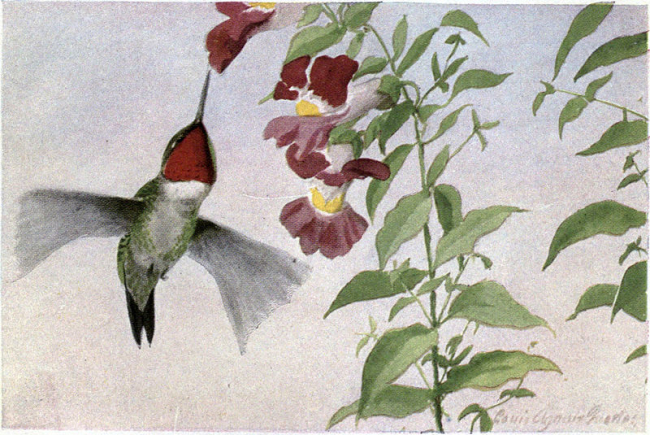 It doesn’t seem like spring in North Carolina until the ruby throated hummingbirds return. These amazing little birds with their humming wings and squeaky call are among the favorite things in our garden each spring. Our family waits each year, hoping against hope that they’ll return to us and without fail our little friends show up and spend much of the year with us.
It doesn’t seem like spring in North Carolina until the ruby throated hummingbirds return. These amazing little birds with their humming wings and squeaky call are among the favorite things in our garden each spring. Our family waits each year, hoping against hope that they’ll return to us and without fail our little friends show up and spend much of the year with us.
Ruby throated hummingbirds are my family’s favorite birds. It’s an exciting day for us when they arrive in the spring and we’re saddened when we realize they’ve all left us for the winter. In this post, I’m sharing a bit about our experience with these charming little birds and the ways we care for them while they are visiting us.
Ruby throated hummingbird photo licensed by Joe Schneid under the Creative Commons Attribution 3.0 Unported license.
Hello, Anyone Home?

We’ve come to believe that it’s the same ruby throated hummingbirds that visit our yard each year. There’s just certain things that they do that it would seem strange birds wouldn’t know to do…for example, they let us know when they’ve arrived.
Yes, these teeny little birds tell us that they are back and it’s time for us to put the feeders out. No, we don’t see them flitting around the flowers. And, no we don’t hear their characteristic calls.
Our returning ruby throated hummingbirds actually ask us to feed them. They visit one of three windows in our house – my office window, mom’s desk window or the kitchen window over the sink. They seem to know when we’re in the room and they’ll hover in front of us until it seems that we take notice of them. They never hit the window. They don’t seem to hover in front of other windows. As impossible as it sounds, they’ve done this every year for the 10 years we’ve lived in this house.
If their visit with one of us doesn’t work, they even move on to another window in what would seem an attempt to get the other one of us to take notice and put out their feeders.
Beautiful close-up of a male hummingbird courtesy of Cheryl Empey.
Ruby Throated Hummingbirds

We live in North Carolina. According to the North Carolina Museum of Natural Sciences, twelve different species of hummingbirds have visited our state. Some are quite rare with only one or two sightings, others are more frequent visitors. The species spotted here are: Allen’s, Anna’s, black-chinned, blue-throated, broad-billed, broad-tailed, buff-bellied, calliope, green violet-eared, green-breasted mango, ruby-throated and rufous.
The ruby throated hummingbird (Archilochus colubris) is the species most commonly found migrating through the Carolinas. We’ve lived 40 miles inland from the Atlantic Ocean to the Blue Ridge mountains on the western side of our state and a few places in between. These charming and beautiful birds have visited us at each of our homes.
Ruby throated hummingbirds typically arrive in the spring and leave by early October to spend the colder months in Mexico and Central America. However, there have been increasing numbers of birds wintering over in North Carolina, particularly in the Outer Banks area.
Ruby throated hummingbirds are the only hummingbird species that regularly nests east of the Mississippi River. We’ve never been lucky enough to spot one of their nests but we remain hopeful.
The average weight of a full-grown, male ruby throated hummingbird is on average 3.4 grams or 0.12 ounces. In comparison a United States nickel weighs 5 grams and a penny weighs 2.5 grams.
As you might guess from their name, these pretty birds are recognizable for their distinctive red-colored throat feathers. However, the female rufous has some reddish neck feathers and Anna’s have reddish-purple feathers on their heads and necks too.
Generally, only the males have the distinctively colored neck feathers. The females have a light throat patch and have a more rounded, white-tipped tail. Ruby-throats are solitary creatures. Mating lasts seconds and is pretty much the only time the parents will be together – the females are left to their own devices to care for their eggs and raise the chicks. They usually have two eggs at a time and raise two broods during each summer.
Ruby throated hummingbirds eat nectar from flowers and flower trees. They also eat small insects and spiders. They are particularly attracted to red and dark purple flowers. It’s not an accident that so many of the commercial hummingbird food products contain red dye and the feeders often have red on them.
A word about the beautiful Hummingbird Painting in this section…I thought I would share with you the work of one of my favorite artists. Louis Agassiz Fuertes (1874-1927) was an American ornithologist, illustrator and artist best known for his ornithological art. Many compare his work to that of John James Audubon. Personally, I prefer Fuertes’ work.
Smaller Number of Birds Returning?
In 2013, there seemed far fewer ruby throated hummingbirds in our area. Neighborhood feeders remained fairly full as the birds just didn’t seem to be around. A few had shown up early in the season but they just seemed to disappear. I know from past experience that they do seem a bit more elusive while nesting but people were actually giving up on their feeders.
Quite late in the season they seemed to return but still in somewhat lower numbers than other years. I have seen a number of articles online where other regions are reporting similar apparent population declines.
In 2014, the birds returned on schedule. Problem was, Mother Nature wasn’t ready for winter to be over. We had several nights in a row of below freezing temperatures in May. Again, the neighborhood was worried about our hummingbird friends. Despite the frigid welcome, this year, the ruby throated hummingbird population, at least in our neighborhood, seems to be more normal. YAY!
Learn More About Hummingbirds
Wonderful children’s book that the adults are going to love too. Full of beautiful watercolors by the author, this book shares facts and trivia about hummingbirds including information about the different things they do as the seasons change.
First Flight: A Mother Hummingbird’s Story
How lucky are Honey, Ray and Zen to have chosen the Carroll’s backyard? How lucky are all of us that Don Carroll is a professional photographer?
This charming book shares the Carroll’s experience when Honey, a mamma hummingbird choose their clothesline as the perfect place to build her nest. Through their photographs and the words of Noriko Carroll we are transplanted to their garden and get to watch Honey as she cares for her eggs and teaches Ray and Zen to fly.
There’s even Photographic Notes where Don shares some of the techniques he used to snap his stunning photographs.
The family just released (June 2014) a wonderful DVD – First Flight: A Mother Hummingbird’s Story that they spent three years filming. It stars Honey the Hummingbird along with her children. Noriko narrates the story on the video and everyone who has seen it agrees the cinematography is absolutely wonderful.
Do your hummingbirds communicate with you?
Have you ever observed your hummers trying to tell you something? Our birds let us know when they arrive each spring, when their feeder is empty, when the hornets are causing them problems or even one time when the feeder had fallen off the hook.
These are by far the smallest birds in our garden but they provide the most excitement and fun. They’re our favorites. Do you entertain hummingbirds each spring, are you lucky enough to have them year-round or have these feathered acrobats not visited your home?
About this post…
This article is the first of a three-part series of articles on our backyard ruby throated hummingbirds. This one covers Ruby Throated Hummingbirds in North Carolina. The other articles are How to Keep Bees Away From Hummingbird Feeder and How to Make Hummingbird Food. They were originally published as a single, comprehensive piece on a community-driven website in the spring of 2013. Like much of the web, things change and we have to adapt. So, I’ve moved the information to OurHerbGarden.com along with many of the wonderful comments and conversation that occurred on the other website.


Great article! I enjoy watching hummingbirds. I think they are adorable! I enjoyed looking at the pictures here!
A gorgeous article! Sadly we don’t have hummingbirds where we live in Australia but having read this I wish we did now! Thank you for sharing.
Thank you for the kind words.
No hummingbirds in Australia? Didn’t realize that before writing this article.
Though, I have seen pictures of a number of your native birds and they are among the most beautiful on earth. Birds that we can only gawk at in zoos here, live in your back yards. Though, I must admit, as much as I would love to have such beauties in my backyard, I’m not sure I would do too well with all of the snakes you Aussies have.
I love hummingbirds. Beautiful article!
There’s just something so enchanting about these little guys. Thank you for the positive feedback.
We love to listen to and watch the hummingbirds in our garden. There is plenty of natural nectar for them in the neighborhood, but they do like their feeder! We see them year round here in southern California.
I just want to say that I love this wonderful article!!! 😉 Thanks for sharing!
You’re welcome and thank you for supporting it. I noticed in your bio that you have a bearded dragon – you haven’t written about him/her yet? They’re such cool animals.
Unfortunately, we don’t have hummingbirds where I live (near Athens, Greece) — but the suburb is quite country-like, and we listen to birds singing all day long.
I’ve never actually seen a hummingbird before. There may not be any around where we live. But I enjoyed reading your lens about them! Awesome!
I have never seen them before except on TV. Some one had sent me a presentation about Humming birds I was amazed at the size of its egg, the speed at which the wings flap etc. Its a wonder of God.
We have up to 16 species of hummingbirds in southeastern Arizona. We got a Ruby-throated last year. People have been reporting large numbers of hummers, and of species this year. In fact, some species that are more rare seem to be better represented this year. I don’t think you need to worry about something happening to them. I’m sure they’ll be back. I have had hummers come and hover in front of me and look me over, but because I don’t feed them, they don’t ask me.